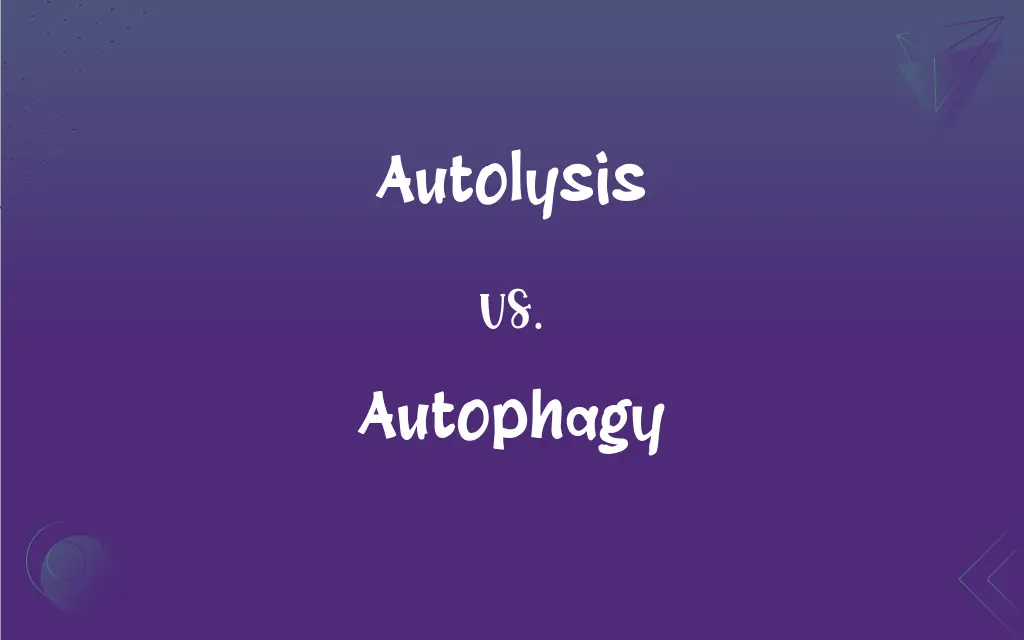Autolysis vs. Autophagy: What's the Difference?
Edited by Harlon Moss || By Janet White || Updated on February 5, 2024
Autolysis is self-digestion by a cell's own enzymes, while autophagy is a cellular process that degrades and recycles cellular components.

Key Differences
Autolysis and autophagy are distinct cellular processes that involve the breakdown of cellular components. Autolysis occurs when a cell self-destructs through the action of its own enzymes, leading to the breakdown of cell components without a regulated mechanism. Autophagy, on the other hand, is a highly regulated process where cells degrade and recycle their own components through the lysosome, an organelle that contains digestive enzymes.
Autolysis typically happens after cell death, contributing to the decay of tissues, whereas autophagy is a survival mechanism that occurs in living cells. Autophagy helps cells to cope with stress conditions by recycling damaged or unnecessary cellular components, thereby promoting cell survival. In contrast, autolysis signifies the end of cellular life, leading to the release of enzymes that break down cell structures.
The regulatory mechanisms of autolysis and autophagy differ significantly. Autolysis is considered an uncontrolled process that occurs when cellular integrity is compromised, without the need for specific signaling pathways. Autophagy is tightly controlled by a complex set of signaling pathways that ensure cellular homeostasis is maintained, responding to various stimuli including nutrient starvation, hypoxia, and infection.
In the context of disease, autolysis and autophagy play different roles. Autolysis can contribute to the pathology of diseases, especially in conditions leading to tissue necrosis. Autophagy, however, often acts as a protective mechanism, helping to prevent disease by eliminating pathogens and damaged organelles, and has been implicated in cancer, neurodegeneration, and immune responses.
Despite their differences, both autolysis and autophagy are essential for understanding cellular responses to stress and the maintenance of cellular health. Autolysis represents a passive process of cellular breakdown, while autophagy represents an active, regulated process crucial for cell survival, adaptation, and homeostasis.
ADVERTISEMENT
Comparison Chart
Definition
Self-digestion by a cell's own enzymes.
Cellular process that degrades and recycles components.
Process Nature
Uncontrolled and passive.
Highly regulated and active.
Occurrence
After cell death.
In living cells, under stress.
Role in Cellular Health
Contributes to tissue decay.
Promotes survival by recycling components.
Implications in Disease
Can lead to tissue necrosis.
Acts as a protective mechanism against diseases.
ADVERTISEMENT
Regulatory Mechanisms
Lacks specific signaling pathways.
Controlled by complex signaling pathways.
Relationship with Cell Survival
Signifies the end of cellular life.
Aids in maintaining cell survival and homeostasis.
Autolysis and Autophagy Definitions
Autolysis
A process leading to cellular breakdown and tissue decay.
Autolysis of cardiac tissue can complicate post-mortem examinations.
Autophagy
A cellular housekeeping mechanism to maintain homeostasis.
Through autophagy, cells eliminate damaged mitochondria, preventing oxidative stress.
Autolysis
The self-digestion of cells by their own enzymes.
After death, autolysis contributes to the decomposition of tissues.
Autophagy
The lysosomal degradation of cellular components.
Autophagy is induced in liver cells to detoxify and recycle toxins.
Autolysis
The breakdown of all components of a cell by its own lysosomal enzymes.
Autolysis plays a critical role in the ripening of certain cheeses.
Autophagy
A response to cellular stress for survival and adaptation.
Autophagy provides energy and building blocks during fasting by recycling cellular components.
Autolysis
Unregulated enzymatic digestion within cells.
Autolysis occurs in plant cells following harvest, affecting food quality.
Autophagy
An essential process for cellular quality control.
Autophagy defects are linked to neurodegenerative diseases by failing to clear protein aggregates.
Autolysis
An intrinsic process of cellular self-destruction.
In winemaking, yeast autolysis releases compounds beneficial to wine's flavor.
Autophagy
The process by which cells degrade and recycle their own components.
Autophagy helps cells survive under nutrient starvation by recycling organelles.
Autolysis
The breaking down of cells or tissues by their own enzymes. Also called self-digestion.
Autophagy
The process of self-digestion by a cell through the action of enzymes originating within the same cell.
Autolysis
The destruction of an organism's cells by enzymes produced by the organism itself.
Autophagy
(cytology) The process of self-digestion by a cell through the action of enzymes originating within the same cell. Often a defensive and/or self-preservation measure.
Autolysis
(pathology) The autodigestion of the tissues of an organism.
Autophagy
(cytology) A type of programmed cell death accomplished through self-digestion.
Autolysis
(pathology) The autocytolysis of blood cells.
Autophagy
(rare) Self-consumption; the act of eating oneself.
Autolysis
(wine) The decomposition of dead yeast cells in wine after fermentation.
Autophagy
The feeding of the body upon itself, as in fasting; nutrition by consumption of one's own tissues.
Autolysis
(baking) A two-stage mixing process where water and flour are combined first before adding leavening and salt.
Autolysis
Lysis of cells or tissues due to enzymatic activity from within the cell, as contrasted with externally induced lysis.
Autolysis
Lysis (self-digestion) of tissues when they are detached from the organism
FAQs
What roles do autolysis and autophagy play in disease?
Autolysis can lead to tissue damage, whereas autophagy can protect against disease by recycling damaged components.
What is autolysis?
Autolysis is the self-digestion of cells by their own enzymes, typically occurring after cell death.
Are autolysis and autophagy regulated processes?
Autolysis is unregulated, while autophagy is tightly controlled by cellular signaling.
Can autolysis occur in living organisms?
Typically, autolysis occurs after cell death, not in living organisms.
Is autophagy considered a survival mechanism?
Yes, autophagy is a survival mechanism that helps cells adapt to stress by recycling components.
What triggers autophagy?
Autophagy is triggered by various stressors, including nutrient starvation, hypoxia, and infection.
How do autolysis and autophagy differ in occurrence?
Autolysis happens post-mortem, while autophagy occurs in living cells facing stress.
What is autophagy?
Autophagy is a cellular process that degrades and recycles cellular components to maintain homeostasis.
What triggers autolysis?
Autolysis is triggered by the breakdown of cellular integrity, often after death.
How do environmental factors influence autolysis and autophagy?
Environmental factors like temperature affect autolysis speed, while nutrients and stress levels can induce autophagy.
How is autophagy beneficial for cell health?
Autophagy promotes cell survival and health by recycling unnecessary or damaged cellular components.
Can autophagy prevent diseases?
Yes, by removing damaged organelles and proteins, autophagy can prevent diseases like cancer and neurodegeneration.
How is autophagy regulated?
Autophagy is regulated by a complex network of signaling pathways that respond to cellular and environmental cues.
Can autophagy be therapeutically targeted?
Yes, modulating autophagy is a therapeutic strategy in diseases like cancer, neurodegeneration, and infections.
Does autolysis have any beneficial effects?
While autolysis is part of natural decay, it can be beneficial in controlled environments like cheese ripening.
How does autolysis affect food quality?
Autolysis can impact food quality negatively by causing spoilage, or positively by enhancing flavors in fermented products.
What is the role of lysosomes in autolysis and autophagy?
Lysosomes execute autolysis by degrading cell components, and they are crucial for the degradation process in autophagy.
Can autolysis be prevented or delayed?
Techniques like refrigeration can delay autolysis by slowing down enzymatic activity.
What is the connection between autophagy and immunity?
Autophagy plays a role in immunity by eliminating pathogens and presenting antigens to immune cells.
Is autophagy involved in aging?
Autophagy plays a role in aging by affecting cellular turnover and damage accumulation.
About Author
Written by
Janet WhiteJanet White has been an esteemed writer and blogger for Difference Wiki. Holding a Master's degree in Science and Medical Journalism from the prestigious Boston University, she has consistently demonstrated her expertise and passion for her field. When she's not immersed in her work, Janet relishes her time exercising, delving into a good book, and cherishing moments with friends and family.
Edited by
Harlon MossHarlon is a seasoned quality moderator and accomplished content writer for Difference Wiki. An alumnus of the prestigious University of California, he earned his degree in Computer Science. Leveraging his academic background, Harlon brings a meticulous and informed perspective to his work, ensuring content accuracy and excellence.
































































